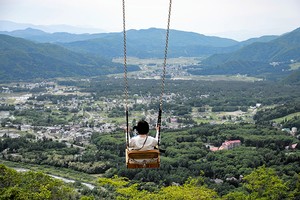By LISA VOGT/ Special to Asahi Weekly
August 6, 2024 at 07:00 JST
 A flight of stone steps leads visitors to Oyama Afuri shrine in Isehara, Kanagawa Prefecture. Making a visit to the shrine, said to have been built over 2,000 years ago, is called Oyama Mairi. The shrine can be easily accessed by cable car. The view from the shrine has been awarded 2 stars in the Michelin Green Guide Japan. (Photo by Lisa Vogt)
A flight of stone steps leads visitors to Oyama Afuri shrine in Isehara, Kanagawa Prefecture. Making a visit to the shrine, said to have been built over 2,000 years ago, is called Oyama Mairi. The shrine can be easily accessed by cable car. The view from the shrine has been awarded 2 stars in the Michelin Green Guide Japan. (Photo by Lisa Vogt)
There are various kinds of pilgrimages: a nature pilgrimage, an ancestral pilgrimage, a personal pilgrimage to someone or somewhere dear to you (for example, to the tombstone of a beloved artist), and a traditional pilgrimage to a sacred place, to list a few.
In the Edo Period (1603-1867), travel within Japan was strictly controlled and people had to have a valid reason to hit the road.
Hence, there are sekisho, old domestic checkpoints, throughout the country. Kanko and kankokyaku didn’t exist. Note that the kanji for kanko is to “see” and be “enlightened.”
The only way regular folk could travel was on a pilgrimage, and Oyama Mairi was one of the most famous destinations. That is because walking to Oyama in today’s Isehara, Kanagawa Prefecture, was relatively easy, only two or three days walk from Edo, compared to, say, the more demanding Shikoku Ohenro or Kumano Kodo.
Truth be told, a pilgrimage to Oyama was also a much-anticipated fun getaway. It is said that an incredible one-fifth of Edo’s inhabitants traveled to Mount Oyama each year.
But only men were allowed to put on their “waraji” straw sandals and travel. Women had to stay at home and wait for the men in their lives to return with stories of the journey. I suspect that many ladies didn’t mind that much and enjoyed having precious time to themselves.
Oyama blossomed as a hub for Oyama Kanze-ryu Noh theater and comedic rakugo performances. People drank, partied, shopped, and had a good time. Shukuba inns catered to the whims of the pilgrims, restaurants served fresh tofu made with pristine mountain water, and merchants sold souvenirs. Many ukiyo-e woodblock prints depict Mount Oyama and the pilgrimage.
Today, there are two places of worship: Oyamadera Buddhist temple, which houses an iron Fudo Myo-o (a Wisdom King who changes anger into salvation), and Oyama Afuri Shinto shrine.
The 1,252-meter mountain is often shrouded in rain clouds and is sometimes called Amefuri-yama. Deities of mountain, water and thunder are enshrined here, so people who hope for rain to fall or stop are encouraged to pay a visit to pray.
The wall of a tofu restaurant I visited was adorned with four-character calligraphy that read shingemuhou, which I interpret as “we create our world through our beliefs.” A pilgrimage to Oyama, or anywhere for that matter, can be kanko, a chance to open one’s eyes, heart and head to learn--an enjoyable mini-vacation with a spiritual bent.
***
This article by Lisa Vogt, a Washington-born and Tokyo-based photographer, originally appeared in the June 2 issue of Asahi Weekly. It is part of the series "Lisa’s Things, Places and Events," which depicts various parts of the country through the perspective of the author, a professor at Aoyama Gakuin University.




















A peek through the music industry’s curtain at the producers who harnessed social media to help their idols go global.
A series based on diplomatic documents declassified by Japan’s Foreign Ministry
Here is a collection of first-hand accounts by “hibakusha” atomic bomb survivors.
Cooking experts, chefs and others involved in the field of food introduce their special recipes intertwined with their paths in life.
A series about Japanese-Americans and their memories of World War II